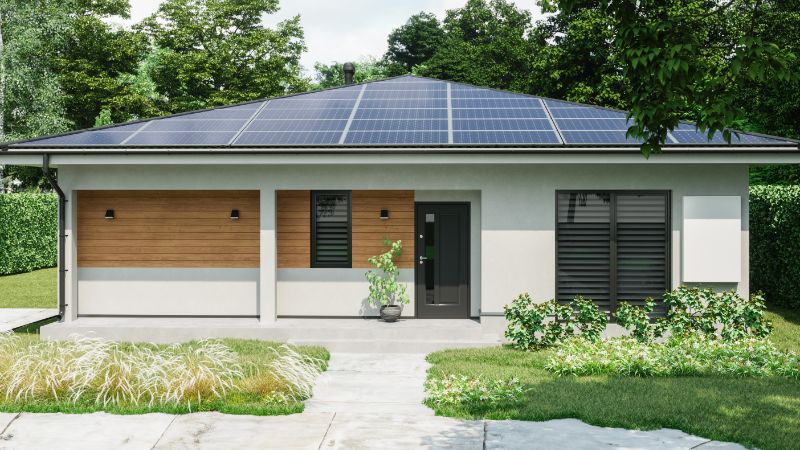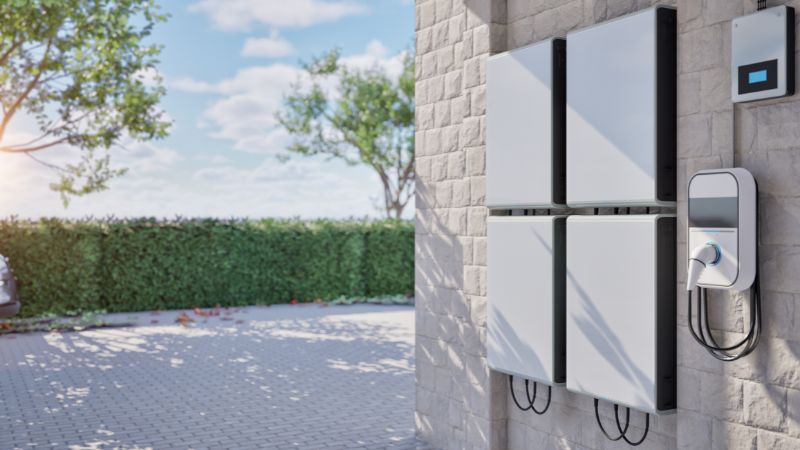Many homeowners with solar panels soon realize their system only generates power when the sun is out. This means that during the night or on overcast days, you are still dependent on the utility grid for electricity. By adding a battery, you can fundamentally change how your solar setup works.
A battery storage system allows you to store the surplus energy your solar panels generate during peak sunlight hours. This captured power can then be used whenever you need it, day or night. This straightforward upgrade is the key to achieving true energy independence, providing vital backup power during outages, and ultimately, maximizing the return on your solar investment.

Why Should You Add a Battery to Your Solar System?
Integrating a battery with your solar panels gives you significantly more control over how you use your energy. It elevates your solar installation from a part-time power generator into a comprehensive, around-the-clock energy solution.
Achieving Greater Energy Independence
A solar battery enhances a homeowner’s energy self-sufficiency by storing excess power that would otherwise be sent to the grid. This allows homeowners to use their own stored solar energy during expensive peak-rate hours or after sunset, reducing their dependence on utility companies. This independence serves as a buffer against escalating electricity prices and leads to more predictable energy expenses. For instance, a homeowner could store 10 kWh of solar energy generated at midday to power their home during the evening hours from 6 PM to 10 PM.
Ensuring Backup Power
A battery offers crucial backup power in the event of a grid failure. While solar panels alone are designed to shut down during an outage for safety reasons, a battery system can keep your essential appliances operational. This backup capability ensures that refrigerators, lights, and important medical devices continue to function without interruption. A standard home battery, such as a 13.5 kWh unit, can typically power critical circuits for anywhere from 10 to 24 hours, depending on the household’s energy consumption.
Essential Components for a Battery Addition
To add a battery to an existing solar system, three main components are required. Each plays a distinct and vital role in the storage and management of your solar energy.
The Battery
The battery is the core component that physically stores the energy produced by your solar panels for later use, acting as a personal reservoir for your solar power.
- Batteries can be connected in series or parallel to achieve the necessary voltage and current for your system.
- A Battery Management System (BMS) is essential for monitoring the health of the battery cells and ensuring safe, reliable operation.
- To maintain optimal operating temperatures and extend its lifespan, the battery requires proper thermal regulation, often managed by an HVAC system.
The Battery-Based Inverter
A hybrid or battery-based inverter is responsible for directing the flow of electricity between your solar panels, the battery, and your home’s electrical system.
- It converts the DC power generated by the solar panels and stored in the battery into the AC power required by your home appliances.
- It intelligently charges the battery using any excess solar power generated during the day.
- It can draw power from the battery to supply your home’s needs or even export it back to the grid when it’s advantageous to do so.
The Battery Installation Procedure
A certified professional should oversee the entire installation, which involves a thorough assessment, the physical setup, and the final system activation. This methodical process guarantees safety, adherence to regulations, and the best possible performance from your new battery storage system.
Professional Evaluation and System Design
A qualified installer will begin by performing a detailed site assessment and energy audit. This step is crucial for determining the appropriate battery size and the best location for installation by analyzing factors like roof space, sun exposure, and your home’s historical energy usage. The design phase also involves mapping out wiring paths and ensuring the entire plan complies with local building codes and permit requirements.
System Integration and Commissioning
After the physical installation is complete, the system undergoes a final integration and commissioning phase. This stage involves several key steps to bring the system online.
- System Testing: This verifies that all components are communicating correctly and that all safety features are functioning as they should.
- Configuration: The installer will configure the battery’s operational settings and set up the monitoring platform for daily use.
- Homeowner Training: You will receive instruction on how to operate the system, monitor its performance, and perform basic maintenance.
Battery Types for Solar Power Systems
When adding a battery to a solar system, homeowners typically choose between two main types of batteries. Both lead-acid and lithium-ion batteries have unique characteristics that make them suitable for different energy storage applications.
Lead-Acid Batteries
Lead-acid batteries are a time-tested technology, offering a dependable and budget-friendly storage solution that has been used in solar applications for decades.
- They come in flooded lead-acid (FLA) or sealed lead-acid (SLA) varieties, including Absorbent Glass Mat (AGM) and Gel types.
- Their upfront cost is generally lower than that of lithium-ion batteries.
- They are resilient to overcharging and deep discharging.
- Flooded types require proper ventilation and periodic refilling with distilled water.
- Their typical lifespan is between 5 to 8 years, or about 1,000 to 3,000 charge cycles.
- They have a lower depth of discharge (DoD), usually around 60% of their total capacity.
These batteries are often a good fit for off-grid systems or as a backup power source where the initial cost and larger physical footprint are not major constraints.
Lithium-Ion Batteries
Lithium-iron phosphate (LiFePO4 or LFP) batteries have become the modern industry standard for residential solar energy storage, providing superior efficiency and a much longer operational life.
- They boast an efficiency rating of over 95%, meaning more of your stored energy is usable.
- They offer a depth of discharge (DoD) that exceeds 80%, maximizing their usable capacity.
- Their design is compact and lightweight, which helps save space.
- They require little to no maintenance and do not need special ventilation.
- Their lifespan extends for many thousands of charge cycles, far surpassing lead-acid batteries.
- They require an integrated Battery Management System (BMS) to ensure safety and optimal performance.
| Feature | Lead-Acid | Lithium-Ion (LFP) |
| Cycle Life | ~1,000–3,000 cycles | Many thousands of cycles |
| Depth of Discharge | ~60% | >80% |
| Efficiency | <80% | >95% |
For most residential applications, lithium-ion batteries are the preferred choice, particularly when efficiency, a smaller footprint, and long-term value are the main priorities.

Financials: Costs and Incentives
Adding a battery to your solar system does require a notable initial investment, but a variety of incentives and long-term savings make it a more financially attractive option. These considerations include the upfront installation cost, available rebates, and tax credits.
How Much Does a Solar Battery Cost?
The cost for a fully installed solar battery storage system typically falls between $6,000 and $23,000. In 2025, an average 11.4 kWh battery system costs approximately $9,000 to $10,000. This price can vary based on three main factors: the capacity of the battery, the complexity of the installation, and the specific brand of equipment chosen. Homeowners can recoup this initial expense over time through savings on their electricity bills by using stored solar power during high-cost peak hours.
Available Rebates and Tax Credits
Several financial incentives are available that can significantly lower the net cost of installing a solar battery.
- You can claim the 30% federal Investment Tax Credit (ITC) on the total cost of both the solar panels and the battery storage system.
- It is worth researching state and local incentives, which may include property tax exemptions or sales tax exemptions on the purchase of the equipment.
- Solar financing options, such as loans, leases, and power purchase agreements (PPAs), can help manage the upfront cost.
The federal ITC provides the most substantial savings, but it is currently set to be available for systems installed by December 31, 2025.
Conclusion
Adding a battery to an existing solar panel system is a significant upgrade that transforms it from a simple daytime power generator into a full-time energy solution. It is a practical move toward achieving genuine energy independence and making your household more resilient.
Homeowners can enjoy the peace of mind that comes with having reliable backup power and gaining more control over their energy expenses. With professional installation and the financial incentives available, it is an investment that provides value for many years.
Frequently Asked Questions
Why should I add a battery to my solar panel system? Adding a battery allows you to store the excess solar energy your panels produce during the day. You can then use this stored energy at night or during power outages. This enhances your energy independence, lowers your reliance on the grid, and provides backup power, keeping essential appliances running when the utility grid goes down. It effectively turns your solar panels into a 24/7 energy solution, maximizing your initial investment.
What are the primary benefits of a solar battery? The main advantages are increased energy self-sufficiency and having a reliable backup power source. You can use your stored solar power during peak electricity rate periods to reduce costs and at night to avoid purchasing energy from the utility. During an outage, a standard home battery can power crucial circuits for 10 to 24 hours.
What kinds of batteries are used for home solar systems? The two principal types are lead-acid and lithium-ion batteries. Lead-acid batteries are a more affordable option, often used for backup power. Lithium-ion batteries, particularly LiFePO4 models, are more efficient, last longer, and are the preferred option for most homeowners because they save space and offer better long-term value.
What equipment is required to add a battery to my system? You will need the battery itself and a battery-based (or hybrid) inverter. The battery stores the energy and relies on a Battery Management System (BMS) for monitoring and safety. The inverter manages the flow of electricity, converting DC power from the panels and battery into usable AC power for your home, while also directing surplus solar energy to charge the battery.
What does the installation process for a solar battery involve? A qualified professional should always handle the installation. The process starts with a site assessment to determine the correct battery size and placement. This is followed by the physical installation of the components and the final system integration. The installer will make sure everything is compliant with local codes, test the system to ensure it operates correctly, and provide you with training on its use and maintenance.
What is the cost of a solar battery, and are there incentives? The initial investment for a battery system typically ranges from $6,000 to $23,000. You can offset this expense over time through savings on your electricity bills. A major incentive is the 30% federal Investment Tax Credit (ITC), which is available for systems installed by the end of 2025. You may also find additional state and local incentives, such as rebates or special financing options.






